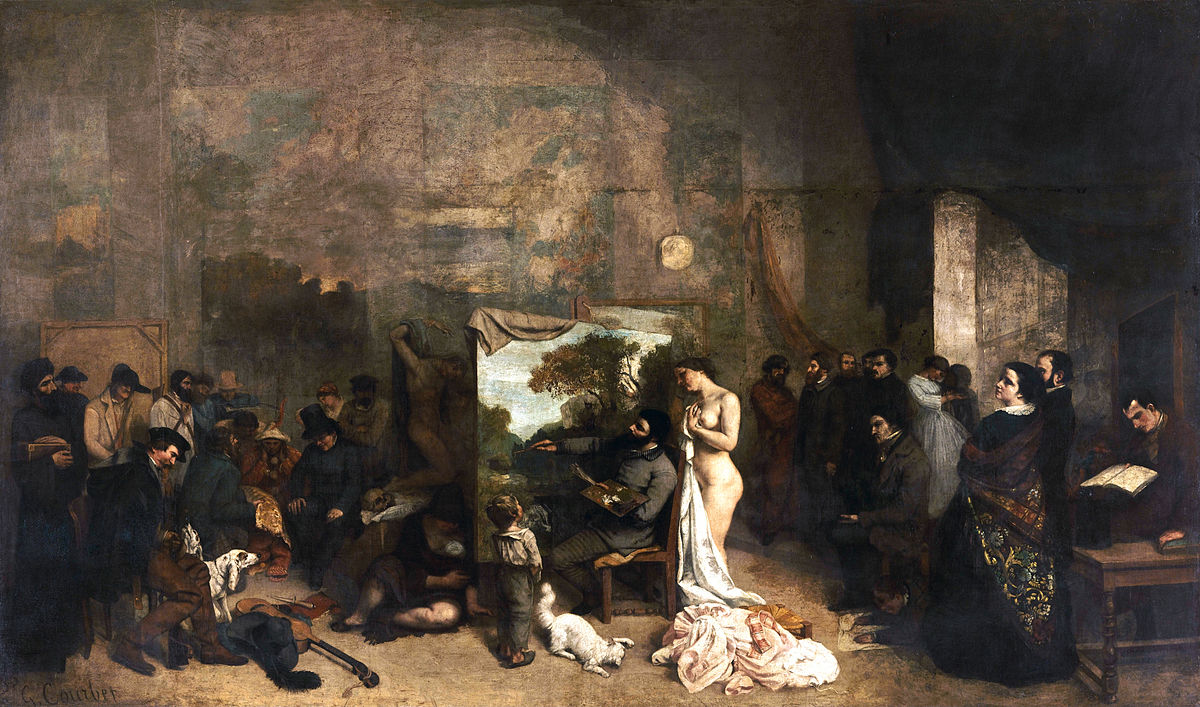49
Another category of refashioning must be mentioned here: the refashioning that occurs within a single medium-for example, when a film borrows from an earlier film, as Strange Days borrows from Vertigo or when a painting incorporates another painting, as in Courbet's “Interior of My Studio”. This kind of borrowing is perhaps the most common, because artists both know and depend most immediately on predecessors in their own medium.[…]Refashioning within the medium is a special case of remediation, and i t proceeds from the same ambiguous motives of homage and rivalry—what Harold Bloom has called the "anxiety of influence”—as do other remediations. Much of what critics have learned about this special kind of refashioning can also help us explore remediation in general. At the very least, their work reminds us that refashioning one's predecessors is key to understanding representation in earlier media. It becomes less surprising that remediation should also be the key to digital media.
Another category of refashioning must be mentioned here: the refashioning that occurs within a single medium-for example, when a film borrows from an earlier film, as Strange Days borrows from Vertigo or when a painting incorporates another painting, as in Courbet's “Interior of My Studio”. This kind of borrowing is perhaps the most common, because artists both know and depend most immediately on predecessors in their own medium.[…]Refashioning within the medium is a special case of remediation, and i t proceeds from the same ambiguous motives of homage and rivalry—what Harold Bloom has called the "anxiety of influence”—as do other remediations. Much of what critics have learned about this special kind of refashioning can also help us explore remediation in general. At the very least, their work reminds us that refashioning one's predecessors is key to understanding representation in earlier media. It becomes less surprising that remediation should also be the key to digital media.
Another category of refashioning must be mentioned here: the refashioning that occurs within a single medium-for example, when a film borrows from an earlier film, as Strange Days borrows from Vertigo or when a painting incorporates another painting, as in Courbet's “Interior of My Studio”. This kind of borrowing is perhaps the most common, because artists both know and depend most immediately on predecessors in their own medium.[…]Refashioning within the medium is a special case of remediation, and i t proceeds from the same ambiguous motives of homage and rivalry—what Harold Bloom has called the "anxiety of influence”—as do other remediations. Much of what critics have learned about this special kind of refashioning can also help us explore remediation in general. At the very least, their work reminds us that refashioning one's predecessors is key to understanding representation in earlier media. It becomes less surprising that remediation should also be the key to digital media.
Another category of refashioning must be mentioned here: the refashioning that occurs within a single medium-for example, when a film borrows from an earlier film, as Strange Days borrows from Vertigo or when a painting incorporates another painting, as in Courbet's “Interior of My Studio”. This kind of borrowing is perhaps the most common, because artists both know and depend most immediately on predecessors in their own medium.[…]Refashioning within the medium is a special case of remediation, and i t proceeds from the same ambiguous motives of homage and rivalry—what Harold Bloom has called the "anxiety of influence”—as do other remediations. Much of what critics have learned about this special kind of refashioning can also help us explore remediation in general. At the very least, their work reminds us that refashioning one's predecessors is key to understanding representation in earlier media. It becomes less surprising that remediation should also be the key to digital media.
Another category of refashioning must be mentioned here: the refashioning that occurs within a single medium-for example, when a film borrows from an earlier film, as Strange Days borrows from Vertigo or when a painting incorporates another painting, as in Courbet's “Interior of My Studio”. This kind of borrowing is perhaps the most common, because artists both know and depend most immediately on predecessors in their own medium.[…]Refashioning within the medium is a special case of remediation, and i t proceeds from the same ambiguous motives of homage and rivalry—what Harold Bloom has called the "anxiety of influence”—as do other remediations. Much of what critics have learned about this special kind of refashioning can also help us explore remediation in general. At the very least, their work reminds us that refashioning one's predecessors is key to understanding representation in earlier media. It becomes less surprising that remediation should also be the key to digital media.
Another category of refashioning must be mentioned here: the refashioning that occurs within a single medium-for example, when a film borrows from an earlier film, as Strange Days borrows from Vertigo or when a painting incorporates another painting, as in Courbet's “Interior of My Studio”. This kind of borrowing is perhaps the most common, because artists both know and depend most immediately on predecessors in their own medium.[…]Refashioning within the medium is a special case of remediation, and i t proceeds from the same ambiguous motives of homage and rivalry—what Harold Bloom has called the "anxiety of influence”—as do other remediations. Much of what critics have learned about this special kind of refashioning can also help us explore remediation in general. At the very least, their work reminds us that refashioning one's predecessors is key to understanding representation in earlier media. It becomes less surprising that remediation should also be the key to digital media.
 Log-in
Log-in Source type: picture
Source type: picture Source type: picture
Source type: picture Source type: picture
Source type: picture